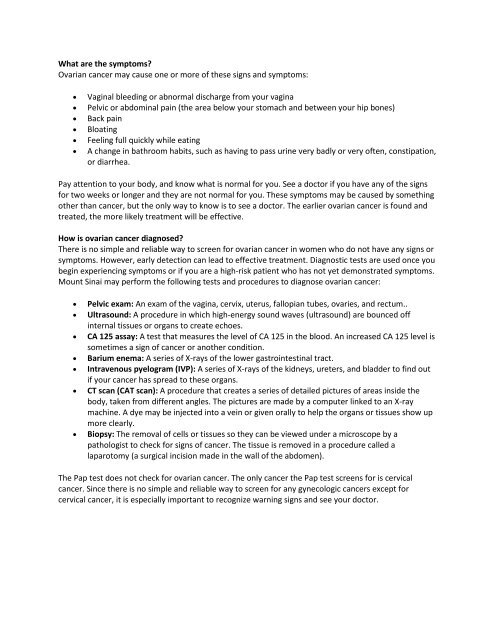Ovarian Cancer FAQs - Mount Sinai Hospital
Ovarian Cancer FAQs - Mount Sinai Hospital
Ovarian Cancer FAQs - Mount Sinai Hospital
Create successful ePaper yourself
Turn your PDF publications into a flip-book with our unique Google optimized e-Paper software.
What are the symptoms?<strong>Ovarian</strong> cancer may cause one or more of these signs and symptoms:• Vaginal bleeding or abnormal discharge from your vagina• Pelvic or abdominal pain (the area below your stomach and between your hip bones)• Back pain• Bloating• Feeling full quickly while eating• A change in bathroom habits, such as having to pass urine very badly or very often, constipation,or diarrhea.Pay attention to your body, and know what is normal for you. See a doctor if you have any of the signsfor two weeks or longer and they are not normal for you. These symptoms may be caused by somethingother than cancer, but the only way to know is to see a doctor. The earlier ovarian cancer is found andtreated, the more likely treatment will be effective.How is ovarian cancer diagnosed?There is no simple and reliable way to screen for ovarian cancer in women who do not have any signs orsymptoms. However, early detection can lead to effective treatment. Diagnostic tests are used once youbegin experiencing symptoms or if you are a high-risk patient who has not yet demonstrated symptoms.<strong>Mount</strong> <strong>Sinai</strong> may perform the following tests and procedures to diagnose ovarian cancer:• Pelvic exam: An exam of the vagina, cervix, uterus, fallopian tubes, ovaries, and rectum..• Ultrasound: A procedure in which high-energy sound waves (ultrasound) are bounced offinternal tissues or organs to create echoes.• CA 125 assay: A test that measures the level of CA 125 in the blood. An increased CA 125 level issometimes a sign of cancer or another condition.• Barium enema: A series of X-rays of the lower gastrointestinal tract.• Intravenous pyelogram (IVP): A series of X-rays of the kidneys, ureters, and bladder to find outif your cancer has spread to these organs.• CT scan (CAT scan): A procedure that creates a series of detailed pictures of areas inside thebody, taken from different angles. The pictures are made by a computer linked to an X-raymachine. A dye may be injected into a vein or given orally to help the organs or tissues show upmore clearly.• Biopsy: The removal of cells or tissues so they can be viewed under a microscope by apathologist to check for signs of cancer. The tissue is removed in a procedure called alaparotomy (a surgical incision made in the wall of the abdomen).The Pap test does not check for ovarian cancer. The only cancer the Pap test screens for is cervicalcancer. Since there is no simple and reliable way to screen for any gynecologic cancers except forcervical cancer, it is especially important to recognize warning signs and see your doctor.



![December 2, 2012 [PDF] - Mount Sinai Hospital](https://img.yumpu.com/51092274/1/190x245/december-2-2012-pdf-mount-sinai-hospital.jpg?quality=85)
![January 21, 2013 [PDF] - Mount Sinai Hospital](https://img.yumpu.com/50916550/1/190x245/january-21-2013-pdf-mount-sinai-hospital.jpg?quality=85)

![February 3, 2013 [PDF] - Mount Sinai Hospital](https://img.yumpu.com/50584982/1/190x245/february-3-2013-pdf-mount-sinai-hospital.jpg?quality=85)
![March 18, 2012 [PDF] - Mount Sinai Hospital](https://img.yumpu.com/50462098/1/190x245/march-18-2012-pdf-mount-sinai-hospital.jpg?quality=85)



![Partners Program Guide [PDF] - Mount Sinai Hospital](https://img.yumpu.com/49411954/1/190x245/partners-program-guide-pdf-mount-sinai-hospital.jpg?quality=85)
![March 19 - April 1, 2012 [PDF] - Mount Sinai Hospital](https://img.yumpu.com/48990923/1/190x245/march-19-april-1-2012-pdf-mount-sinai-hospital.jpg?quality=85)
![PGY-1 Residency Application [PDF] - Mount Sinai Hospital](https://img.yumpu.com/48577701/1/190x245/pgy-1-residency-application-pdf-mount-sinai-hospital.jpg?quality=85)


